It’s All About The Teamwork Part 2
By B.E. Smith
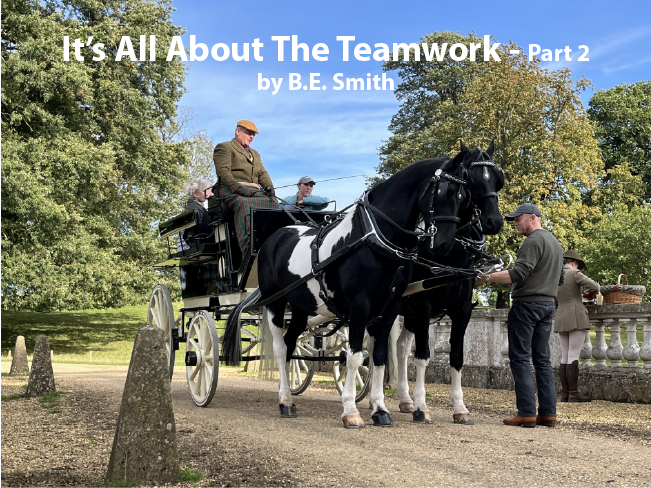
At one time, owning a carriage and the horses with which to pull it, was the fastest way to get from one destination to another. Although the modern automobile has taken over the roads there is still something about riding in a horse drawn carriage that car ride cannot replace. It is a way to simultaneously move through nature while also still feeling like you are a part of it.
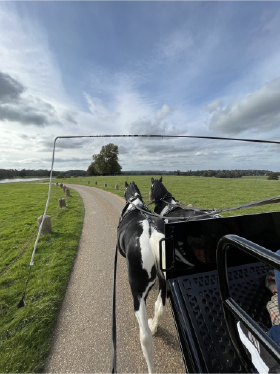
In a car, it is easy to miss miles of scenery just focusing on the road. In a horse drawn carriage, the driver and occupants are encouraged to take that scenery in. It is more than pretending you’ve stepped into the world of Bridgerton. Riding in a carriage in the modern day feels like an adventure. David West and Westways Carriages, based in Bedfordshire, U.K. provides just such an experience. West is well versed in all things having to do with the horse drawn carriage; From the small museum’s worth of antique carriages he owns, to the work with the horses themselves, he is fully invested in the business and the experience.
West’s first job driving horses was on a working farm. The farm owners had put out an advertisement stating they needed help. Specifically, they needed someone that could drive horses. At the time, West didn’t have much experience with driving horses, but he wasn’t about to let that get in the way. He applied for the job, got it, and learned what he needed to, to get the job done. These early days would lay the framework for what would become West’s lifelong career.
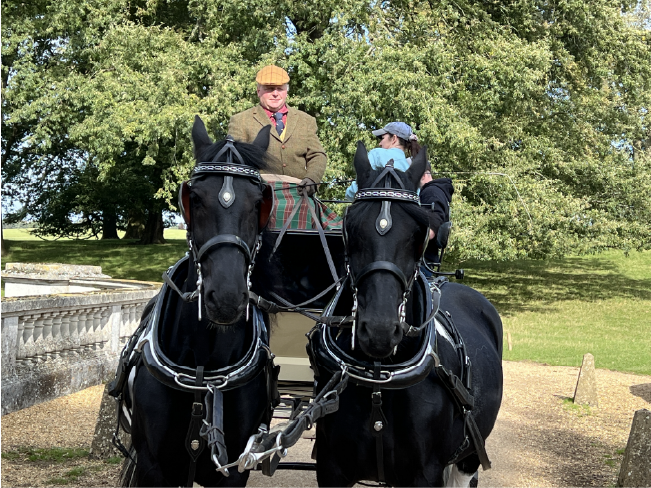
Today, Westways Carriage Horses has several driving teams and a versatile repertoire of carriages. Westways has a certain criterion they look for when shopping for a new pulling team. When speaking with West himself, he stated that he has little interest in pedigree and paperwork. His primary goal is to find two young horses of similar build that complement one another.
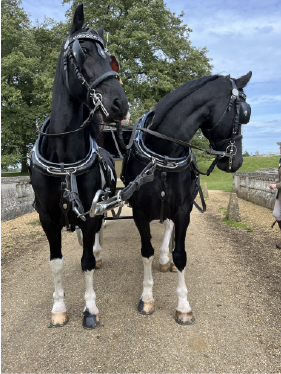 It is no secret that no two horses are the same. Pairing horses together as a team takes not only skill, but hard-earned knowledge. This knowledge is gained through daily work and training regiments. I am sure it will surprise precisely no one that you cannot simply throw a harness on a horse and expect them to pull a carriage with confidence and ease.
It is no secret that no two horses are the same. Pairing horses together as a team takes not only skill, but hard-earned knowledge. This knowledge is gained through daily work and training regiments. I am sure it will surprise precisely no one that you cannot simply throw a harness on a horse and expect them to pull a carriage with confidence and ease.
The calm and confident nature of West’s horses are a credit to his training and nature. Westways Carriage Horses does not rush training. Horses lucky enough to end up here, are allowed to mature before being asked to take on what will ultimately be their career. They are handled daily, bathed regularly, fed well, and provided comfy, well bedded stalls to sleep in. They’re introduced to the harness and fit for their own as they mature.
Surprisingly, the horses are also teamed together based on where they are in their training. Greener horses are not necessarily provided an older, more experienced horse to pair with. What is more important to West is that they work well together, even if that means both horses are a bit green. The rest will work itself out, so long as the horses are able to work harmoniously with one another. West also takes the size of the horse into account when pairing them with their other teammate, as well as the carriage. A smaller horse clearly cannot pull the same size carriage as a larger horse. Smaller horses may be teamed with larger horses to pull larger carriages at times though. In these instances, the biggest and strongest horses are placed at the front of the team. Most of the weight of the carriage and its occupants will fall on these two, regardless of there being more than two horses harnessed up. These two must enjoy the job, but also have the power to get the carriage moving. The teams must complement not only one another, but the carriage itself.
West pairs horses not only by size but by appearance. Uniformity is not strictly necessary for success; however the human eye is drawn to uniformity. West has solid white teams, solid black teams and two black and white, pinto draft cross team, Jack and Bill. The latter two happen to be brothers, but familial relations are not a requirement when putting together a new team. What West saw in these particular horses was more about their builds and personalities. They were both stocky and would grow to be a similar height. They were also both interested in the world around them, which can be helpful in a working horse. Yet, where Bill is a little more likely to respond to his surroundings and even show off a bit, Jack is focused on the work. This works out well for this pair, as Jack was the more dominant personality. As long as Jack is happy to move past or through whatever is in front of them, Bill can be convinced as well. This brings up something that is heard quite often in the equine community. The topic of a “good mind”.
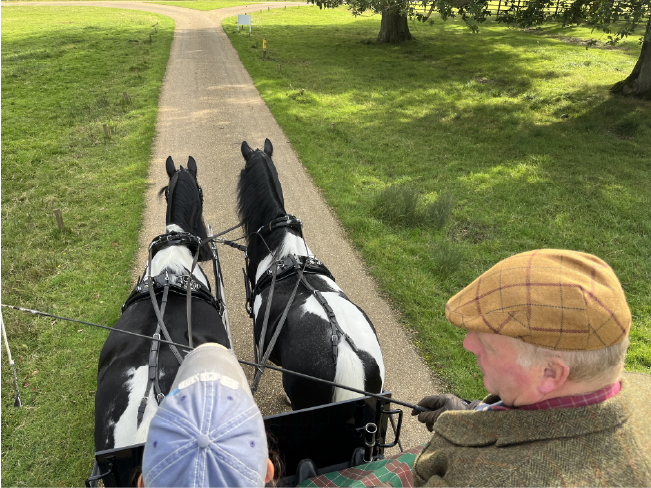
Any equestrian attending a seminar, expo or clinic where someone may ask a higher-level rider or trainer what they look for in a horse will ultimately be told “a good mind” at some point in that conversation. This can be a somewhat confounding or even frustrating response. A good mind is conceptual idea. The definition is ambiguous and slippery. Part of the reason that this answer is always true is because it can be differently applied to a wide range of horses. What makes a horse mentally perfect for one activity, does not make them attractive for another.
A good eventing horse has a competitive spirit, is bold, likes to jump and enjoys running. This same horse may not work out well as a cutting horse, where they need to be focused, patient and, most importantly, not afraid of cows. When West was asked what he looked for in his horses, he gave this same reply. He wants horses with a good mind. A horse with a good mind for pulling is one that enjoys the action, but also does not mind changing surroundings. A horse that wants to work, but also wants to please the humans they work with. A horse that wants to be part of a team. Not just a pair, as they will be working regularly with at least one other horse quite regularly, but the team of humans performing the job as well.
It is easy to see why the mind of the horse is so important to Westways Carriage Horses. Especially, considering their most common type of appointment. These beautiful horses and their kind and gentle trainers are often tasked with the heavy honor of pulling caskets as part of the funeral procession. This is uncommon in most of America, but is quite common in the UK, according to West.
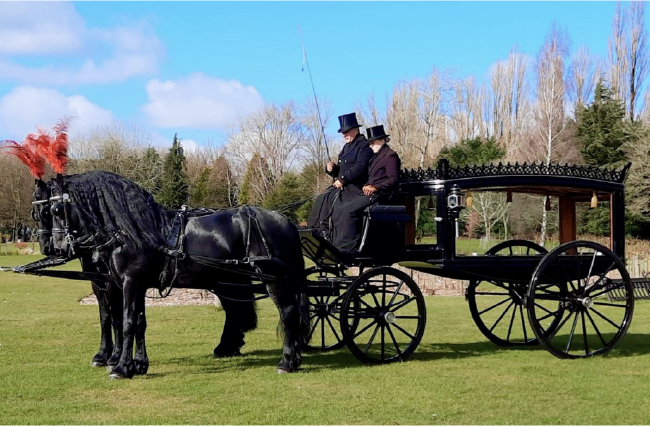
Having calm, focused, and well-behaved horses are necessary when performing such important work. Westways has several carriages devoted to this undertaking. This is so they are sure that they have exactly what is needed on the day of the procession. For, as we all know, a funeral is mostly for the living that attend. It is a way to obtain closure, honor a loved one and bid a final farewell. What more lovely sendoff could anyone provide their loved ones than a final carriage ride, drawn by these magnificent and prepossessing creatures.
Westways Carriage Horses is available for hire for special events as well. If you have a prom coming up and would like to arrive in the style of Cinderella, not only can they accommodate, but they also have a themed carriage to match. Always wanted to arrive or depart from your wedding by way of horse drawn carriage?
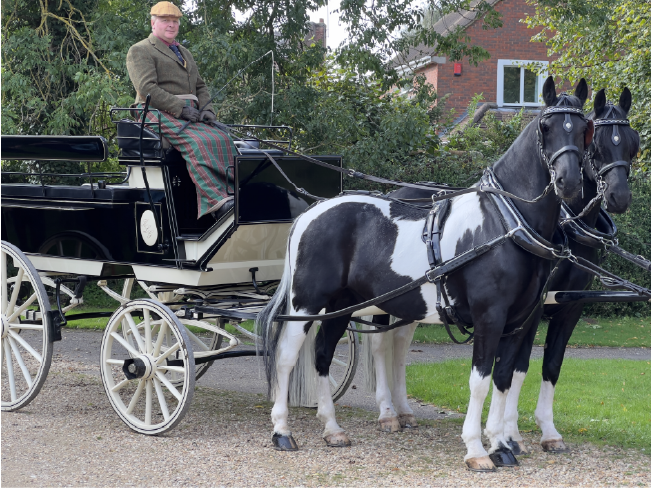
Westways Carriage Horses has multiple options to meet your needs. They also provide carriage rides through historic Woburn Abbey Deer Park. Carriage rides are made possible at the Woburn Deer Park and Estate by kind permission of their Graces The Duke and Duchess of Bedford. The estate is a beautiful property that transports passengers back in time.
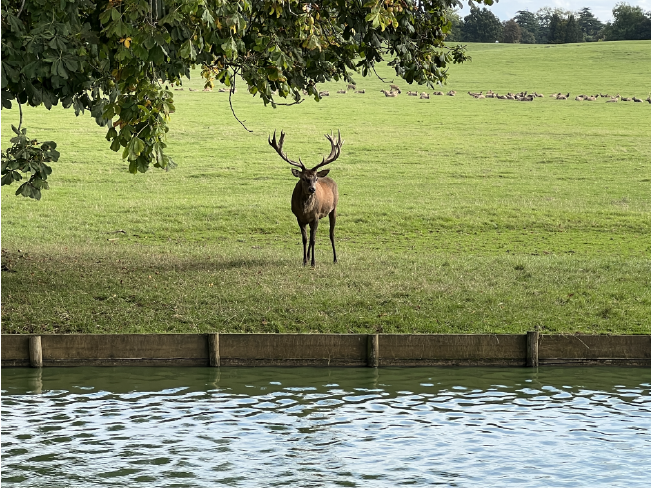
The abbey itself is an imposing and awe-inspiring structure. It sits atop a hill where it stands guard over its protected grounds. The grounds are lush and teeming with life. From the multitudes of deer to the black squirrels sprinting from tree to tree, the park is a haven from the hustle and bustle of every day modern life. Spending an afternoon listening to the gravel crunch beneath wooden wheels and the rhythmic beat of the horses’ feet as the world slowly passes is a bit of heaven on earth. It is nearly meditative. A reminder that there is more to life than work, bills, grocery shopping and that bottomless laundry hamper. Time doesn’t exactly stand still here, but the experience does remind the customer that it is important to slow down and take in the world around them.
Buddhism preaches that Nirvana is a place of peace and happiness. If that is so, then a carriage ride through the park may be a small look into what that may look like. David West and Westways Carriage Horses provides a unique experience and view of the world that is a step out of time and the quickening pulse of contemporary life.
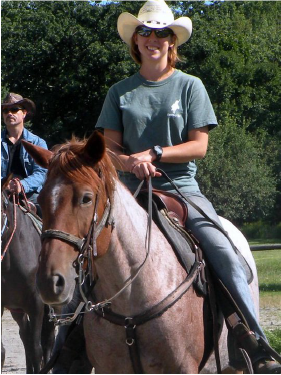 About the author: B.E. Smith has earned her degree in English at Southern New Hampshire University, where she has been an honor roll student, appearing on the Dean’s and President’s lists every semester since enrolling.
About the author: B.E. Smith has earned her degree in English at Southern New Hampshire University, where she has been an honor roll student, appearing on the Dean’s and President’s lists every semester since enrolling.
Her next objective is to publish the horror novel that she is currently working on. The novel takes place in 1941, in the frozen wilderness of Czechoslovakia inside gothic Houska castle; notoriously nicknamed the gateway to hell by the locals.
When she is not writing, Smith spends her time with her husband, dog, cat, and Appendix horse Orla. Smith is a long-time equestrian and is also a certified and accomplished equine massage therapist. She rode horses through childhood, training under Eventing riders. After, high school she chose to head south to work on ranches, where she learned how to ride a less formal style of western. This unfolded naturally into an interest barrel racing. Ultimately, she missed the dressage aspects of her childhood Eventing training and has been training primarily as a dressage rider ever since.
Editor’s Note: An article on the collection of Westways carriages will be coming soon! Lots of interesting notes on everything from Hansom to Harrods to the elegant St. David’s. Check back in to take the tour.



